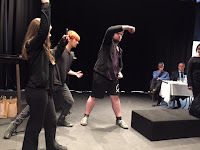-
The ‘Whitescarf’ (the character
who is different from everyone else)
-
The Bystander (The most ‘voiced’
bystander on the bus)
-
The Attacker
-
The ‘helper’ (the character who
agrees with the attacker and often voices their own opinions towards the
whitescarf)
-
The Interceptor (This character
pipes in at times when they feel the attacker is taking things too far, and
tries to stop the attacker from using physical violence)
-
The ‘Filmer’ (This character is
completely silent throughout scenario 1, only holding up their phone to film
the entire encounter)
Plot/theme: The ‘Talking Justice’
performance has two ‘scenarios’
 Scenario 1 takes place on public transport,
a girl with a white scarf sits herself down, the odd one out. Each other
passenger has a different reaction to her, some look away, some look disgusted,
some see her as just another passenger and one even begins to snicker and make
snide remarks (attacker). These remarks soon grow louder after one of the other
passengers (bystander) sits herself down next to the ‘outsider’ as a way of
showing support. The bystander soon begins to grow annoyed, another passenger
tries to make the attacker quiet down as he feels the attackers words are
insulting. After this passengers failed attempt to stop the hateful words, the
bystander begins to argue with the attacker resulting in the attacker punching
the bystander.
Scenario 1 takes place on public transport,
a girl with a white scarf sits herself down, the odd one out. Each other
passenger has a different reaction to her, some look away, some look disgusted,
some see her as just another passenger and one even begins to snicker and make
snide remarks (attacker). These remarks soon grow louder after one of the other
passengers (bystander) sits herself down next to the ‘outsider’ as a way of
showing support. The bystander soon begins to grow annoyed, another passenger
tries to make the attacker quiet down as he feels the attackers words are
insulting. After this passengers failed attempt to stop the hateful words, the
bystander begins to argue with the attacker resulting in the attacker punching
the bystander.
Scenario 2 takes place in a lounge room, a
group of friends are waiting for the footy to come on. They are chatting and
laughing until one points out a ‘viral video’ that’s just come up in breaking
news, another friend identifies it as the video that he saw on Facebook of a
bystander getting punched (Scenario 1). This video soon causes a heated
discussion between the friends, all with their own views on how this event
should have/could have been handled. The views differ from the need for more
laws, to letting the public decide instead. All of this argument is quickly
stopped by one friend who really ‘couldn’t care less’ about the issue and would
rather watch the footy.
Evaluation:
 This performance was very effective. Although everyone was wearing the same clothing, the way each actor presented emotion allowed the audience to clearly determine what sort of character they were without any confusion. The message in the play was put across well, and by having many characters with different views meant that all views were explored, allowing the audience to make their own conclusions.
This performance was very effective. Although everyone was wearing the same clothing, the way each actor presented emotion allowed the audience to clearly determine what sort of character they were without any confusion. The message in the play was put across well, and by having many characters with different views meant that all views were explored, allowing the audience to make their own conclusions.










